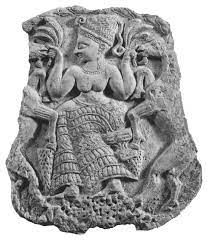

ORIGIN: Amorite, then Canaanite and possibly Phoenician [Lebanon from Tyre northwards, Syria]
TYPE: Mother Goddess
KNOWN PERIOD OF WORSHIP: From prehistoric times circa third millennium BCE until Christianization (circa 400 CE)
SYNONYMS: Athirat
CENTER(S)OF CULT: Ugarit [Ras Samra] and hill shrines throughout the grain-growing coastal region of the Eastern Mediterranean.
ART REFERENCES: none surviving, but onces extensively represented
LITERARY SOURCES: Ugaritic texts from Ras Samra, particularly The Legend of Baal and Anat; Vetus Testamentum.
INFORMATION: Aserah is the great mother goddess of Canaan. Known as "Lady Aserah of the sea", she seems to have lived close by the place of Il, the Canaanite creator god, and is said to have had many sons. She is described as the "creatress of the gods" and the matron of a number of other goddesses who oversee the natural world. SHe is also ambiguous in her attitude toward Baal. She intercedes with Il when Baal wishes to build a palace of his own yet, when he is vanquished, she attempts to place one of her own offspring on the throne. It is Aserah who gave her name to the hill shrines under the trees that were vilified by the writers of the biblical prophetic books such as Ezekiel. Translated as "grove" in the King James English version, the aserah seems to have been a carved wooden pillar that formed the focal point of worship in conjunction with a stone massebah. The aserah represented the presence of the mother goddess. Its popularity with large numbers of Israelites is beyond dispute, but because of its pagan connotations and particularly its representation of the mother goddess linked with rituals of fertility, the aserah became one of the major irritations of the prophets and other religious leaders of the tribes during the period of the Israelite kingship. It may have stimulated large numbers of rank and file to abandon or take a strongly ambivalent attitude toward Yhwhism.